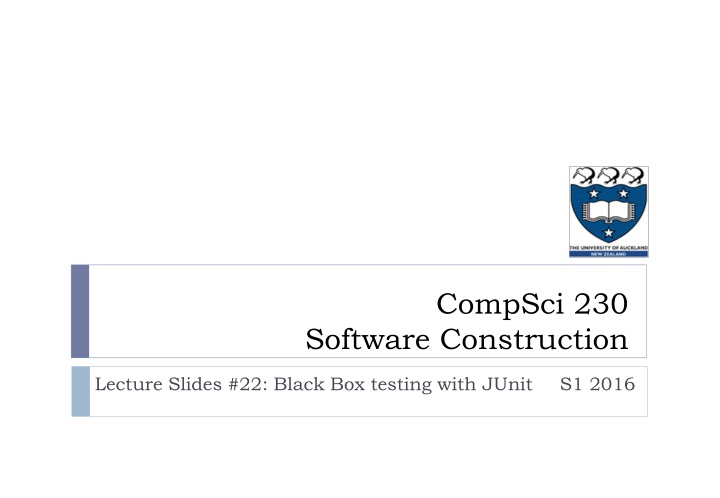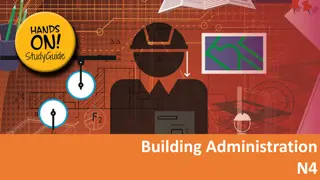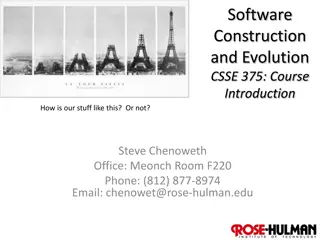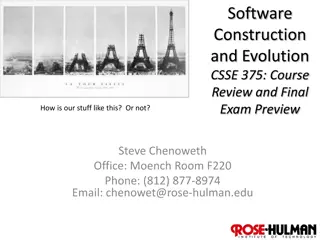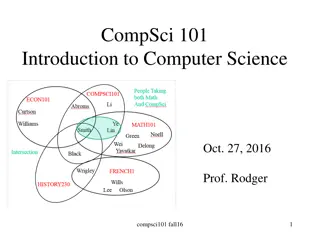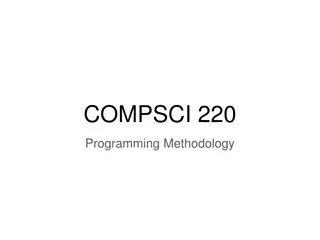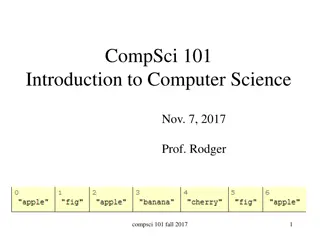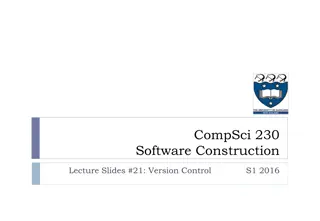CompSci 230 Software Construction
In software construction, black box testing treats the implementation as a black box and focuses on the expected output or behavior. This method involves designing tests that trigger failures, minimizing the number of tests required, and choosing suitable test cases. The goal is to ensure that faults reveal themselves while maintaining an efficient testing process.
Download Presentation

Please find below an Image/Link to download the presentation.
The content on the website is provided AS IS for your information and personal use only. It may not be sold, licensed, or shared on other websites without obtaining consent from the author.If you encounter any issues during the download, it is possible that the publisher has removed the file from their server.
You are allowed to download the files provided on this website for personal or commercial use, subject to the condition that they are used lawfully. All files are the property of their respective owners.
The content on the website is provided AS IS for your information and personal use only. It may not be sold, licensed, or shared on other websites without obtaining consent from the author.
E N D
Presentation Transcript
CompSci 230 Software Construction Lecture Slides #22: Black Box testing with JUnit S1 2016
Agenda Topics: Testing software Testing techniques overview Black Box Testing Picking test cases Writing test cases in JUnit 2 CompSci 230: JU
Testing Different types of testing Purpose of testing? Black-box testing Treat implementation under test as black box (look at it how it interacts with the outside but not at how it is implemented internally) Typically design tests based on which output / behavior we expect for certain input White-box testing Design tests based on implementation itself (structure of code) Try to test all execution paths Usability testing Get user opinion about an implementation 3 CompSci 230: JU
Black-box testing Implementation under test (IUT) is regarded as a black box E.g., IUT could be a class, a method, a module, a service, etc. Tests interact with the IUT s interface E.g., if the IUT is a class, tests interact with the class (or objects of the class) by calling its methods and inspecting their return values Objectives: Design tests so any faults reveal themselves (i.e., trigger failures) Minimise the number of tests required From here, we will assume that the IUT is a class or method and that we will pass parameters and receive return values (or trigger exceptions) 4 CompSci 230: JU
Designing black box tests Design tests so they fail when a fault triggers a failure Tests that trigger intended behavior must not fail Example: A method throws SomeCustomException when invoked with a certain combination of parameters. Suppose this is intended behaviour (i.e., it is what the method should do) A test supplying such a combination must not fail when this exception is thrown (the exception is not a failure in this case). That is: The test must not flag a fail if the exception is thrown and must catch the exception instead The test must fail if the exception is not thrown 5 CompSci 230: JU
Choosing suitable test cases In most cases, the number of possible parameter values that we can pass to a method is practically unlimited Which ones do we choose for our tests? As a general rule, we want to choose those test cases that are most likely to trigger a failure We want to keep the number of test cases small (minimise effort) Writing test cases, identifying suitable test cases, and minimising the number of test cases all require effort. Need to find some sort of compromise 6 CompSci 230: JU
Input partitioning In a lot of cases, we can partition the possible input space Example: An airline flies between a variety of destinations using a variety of aircraft. We have a method that computes which aircraft types can be used on which flight. Input parameters: the shortest runway length of the two airports concerned and the distance between the airports Return value: an array of suitable aircraft types We also know that: Aircraft type 1 requires a minimum runway length of 1800 m and can fly 3000 miles Aircraft type 2 requires a minimum runway length of 2300 m and can fly 5000 miles Aircraft type 3 requires a minimum runway length of 2200 m and can fly 6000 miles 7 CompSci 230: JU
Input partitioning [1,2,3] [2,3] [3] 2300 [3] [1,3] 2200 [ ] [1] Runway [m] 1800 [1] 0 0 3000 6000 5000 Distance [miles] 8 CompSci 230: JU
Input partitioning - observations All parameter value combinations in a partition should give the same return value Testing one value combination from each partition should give us all possible return values Which of these value combinations are worth testing? For some partitions, it s definitely worth testing several combinations, e.g., the red partition Observation from experience: Faults tend to occur mostly at boundaries between partitions Test either side of each boundary 9 CompSci 230: UC
Good and bad test cases Which of the following would make a good test set for our example? 1. (1799 m, 3000 nm), (1799 m, 3001 nm), (1800 m, 1 nm), (1800 m, 3000 nm), (2199 m, 3000 nm), (2199 m, 3001 nm), (2200 m, 3000 nm), (2200 m, 3001 nm), (2200 m, 5000 nm), (2200 m, 5001 nm), (2200 m, 6000 nm), (2200 m, 6001 nm), (2299 m, 3000 nm), (2299 m, 3001 nm), (2299 m, 6000 nm), (2299 m, 6001 nm), (2300 m, 3000 nm), (2300 m, 3001 nm), (2300 m, 5000 nm), (2300 m, 5001 nm), (2300 m, 6000 nm), (2300 m, 6001 nm) 2. (1000 m, 1000 nm), (1000 m, 2000 nm), (1000 m, 3000 nm), (1000 m, 4000 nm), (1000 m, 6000 nm), (1000 m, 7000 nm), (1500 m, 1000 nm), (1500 m, 2000 nm), (1500 m, 3000 nm), (1500 m, 4000 nm), (1500 m, 6000 nm), (1500 m, 7000 nm), (2000 m, 1000 nm), (2000 m, 2000 nm), (2000 m, 3000 nm), (2000 m, 4000 nm), (2000 m, 6000 nm), (2000 m, 7000 nm) , (2500 m, 1000 nm), (2500 m, 2000 nm), (2500 m, 3000 nm), (2500 m, 4000 nm), (2500 m, 6000 nm), (2500 m, 7000 nm) Which of the better test cases would you consider the most important ones? 10 CompSci 230: JU
Test fixtures A test fixture is code that we write for the purpose of testing the IUT Test fixtures set up the environment for a test, e.g., create and configure objects and other variables that we may wish to pass to the IUT Test fixtures can bring the application into a known stable state so test results become reproducible Drivers are pieces of code that invoke methods in IUT Stubs are fake methods that the IUT can call while it is under test give tester full control over the return value may replace methods that have yet to be implemented allow for in-test analysis of the parameters that the IUT actually passes to the method 11 CompSci 230: JU
JUnit JUnit is a test framework for Java Included in Eclipse (but not just Eclipse) JUnit tests are methods in classes At top of the class .java file, we put: import static org.junit.Assert.*; Apart from that, the syntax is as for any other class, with some special additions: Test methods are public void Each method that represents a JUnit test is preceded by an @Test A test class can contain multiple test methods JUnit tests usually also contain a number of special functions Tests pass if the method returns without a call to fail() or a failed assertion 12 CompSci 230: JU
Junit fail() and assertions A call to fail() in a test causes the test to fail We use this if we detect ourselves that the test has failed An assertion describes a condition that must be true in order for the test not to fail A test may still fail even if an assertion in the test is true Junit provides a number of assertion methods: assertEquals(), assertTrue(), assertNull(), assertNotNull(), assertSame(), assertArrayEquals(), A test may contain more than one assertion (but shouldn t contain too many or it becomes difficult to tell why the test failed) 13 CompSci 230: JU
JUnit tests and exceptions If the IUT throws a custom exception (or we expect it to throw a built-in exception under normal operation), then it may be desirable to test if the exception is actually thrown in appropriate test cases If so, we must catch the exception (and then do nothing except maybe check that it was thrown for the expected reasons). If the exception is unexpectedly not thrown, then we must explicitly fail() the test 14 CompSci 230: JU
JUnit example - IUT public class DodgyClass { public int addOne(int x) { return x+1; } public int addAbsoluteValues(int x, int y) { return x + y; } public double reciprocalIfSmallerThan10(double x) throws ArgumentIs10OrLargerException { if (x < 10) { return 1/x; // note this fails for x=0 } else { throw new ArgumentIs10OrLargerException(); } } } 15 CompSci 230: JU
JUnit tests import static org.junit.Assert.*; import org.junit.Test; public class TestDodgyClass { @Test public void testAddOne() { DodgyClass d = new DodgyClass(); assertEquals(5,d.addOne(4)); // test fails if assert fails } @Test public void test1AddAbsoluteValues() { DodgyClass d = new DodgyClass(); assertEquals(8,d.addAbsoluteValues(3,5)); // this assert succeeds by coincidence } @Test public void test2AddAbsoluteValues() { DodgyClass d = new DodgyClass(); assertEquals(8,d.addAbsoluteValues(3,-5)); // this assert fails: test fails } 16 CompSci 230: JU
JUnit tests with exceptions @Test public void test1ReciprocalIfSmallerThan10() { DodgyClass d = new DodgyClass(); try { assertEquals(0.33,d.reciprocalIfSmallerThan10(3),0.01); } catch (Exception e) { // we shouldn't get here if test succeeds, so explicit fail fail("Unexpected exception!"); } } All exceptions should be caught; expected exceptions must be caught with no further action @Test public void test2ReciprocalIfSmallerThan10() { DodgyClass d = new DodgyClass(); try { d.reciprocalIfSmallerThan10(10); // this should throw an exception fail("Didn't throw ArgumentIs10OrLargerException for argument 10"); } catch (ArgumentIs10OrLargerException e) { // just what we wanted, nothing to do here } } 17 CompSci 230: JU
Running JUnit tests in Eclipse Right-click on the test class in the Package Explorer -> Run as -> JUnit Test This runs all tests in the class Results are available on the JUnit tab 18 CompSci 230: JU
Review Give an example of something that black box testing does not do What are we trying to achieve when we design black box tests? In COMPSCI230, students pass right out if they achieve a minimum of 50% of marks in the theoretical part and the practical part. Imagine a method that take the marks for the theoretical and practical parts and returns true for a guaranteed pass and false for a potential fail. Can you draw a diagram showing the input partitioning for these cases? Are JUnit tests drivers or stubs? What happens when an assertion fails? What happens when an assertion holds? What do we need to do if an IUT is supposed to throw an exception in the course of correct operation? 19 CompSci 230: JU
